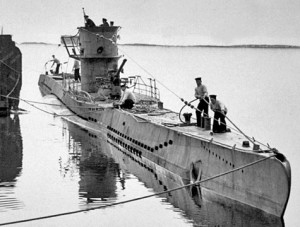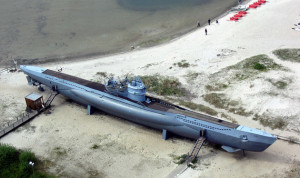How German U-Boats Works
German submarines U-boats – or ‘unterseeboots’, which translates as ‘undersea boats’ – were a series of submarines used in both World War I and World War II. They were famed for their ability to stealthily strike at Allied vessels, ganging up on them in brutally efficient ‘wolf packs’ to inflict the maximum damage. In World War 1 alone, 430 Allied and neutral ships were sunk by these roving packs.
If the might of the U-boat was thought to be at its peak in 1917, however, then by the start of World War II in 1939, they had risen to a whole other level.
Over 50 new German U-boats were built or already in construction and this impressive submarine fleet proceeded to enjoy much success raiding supply lines and sinking Allied vessels. One of the foremost of these next-generation U-boats was the VII-C – the most advanced submarine that had ever been built.
Capable of travelling thousands of miles on the water and then able to submerge and strike enemy targets within a 142-kilometre (88-mile) range, the VII-C was the backbone of Germany’s submarine fleet. Armed with a bounty of torpedoes, sea mines and cannons, the VII-C could deliver damage both on the surface and beneath the waves, as well as tie key areas down with traps and blockades. Indeed, the type II was so successful that between 1940 and 1945 568 vessels were commissioned.
 In contrast to the impressive German fleet, the Allied fleet was inferior both in number and, in general, in its technology. Interestingly though, records indicate that more U-boats were sunk by Allied vessels than vice versa, with HMS Upholder – a U-class submarine -sinking several in the Mediterranean.
In contrast to the impressive German fleet, the Allied fleet was inferior both in number and, in general, in its technology. Interestingly though, records indicate that more U-boats were sunk by Allied vessels than vice versa, with HMS Upholder – a U-class submarine -sinking several in the Mediterranean.
Many of these statistics do not give an accurate portrayal, however, of the overall influence that the German U-boats had during World War II, as their primary purpose was that of economic warfare (eg cutting off supply lines), rather than being solely dedicated to battle.
Navigation – Navigation and detection were handled by a suite of systems including a periscope, radar antenna and magnetic compass. These allowed the U-boat to pick up both surface and undersea targets.
Torpedoes — Five 533mm (21in) torpedo tubes – four in the bow and one in the stern – were installed and left armed for quick attack. A total of 14 torpedoes could be carried at any one time.
 Main gun – The VII-C was equipped with an 8.8cm (3.5in) SK C/35 naval cannon for use on the surface. It could fire armour-piercing, high-explosive and illumination rounds.
Main gun – The VII-C was equipped with an 8.8cm (3.5in) SK C/35 naval cannon for use on the surface. It could fire armour-piercing, high-explosive and illumination rounds.
Hydroplane – Movement underwater was controlled with a series of hydroplanes -short, wing-like appendages that could be angled as desired. Facing them up caused the vessel to dive.
Dive tank – A series of ballast dive tanks were located at the lower front of the vessel. When on the surface these tanks were empty and filled with air; to submerge, they were flooded with water.
Air tank – Almost everything on the U-boat required air to operate, ranging from torpedo launchers to dive tanks. As such, large air tanks were located all over the vessel.
Conning tower – Each VII-C was topped with a conning tower at the centre of the vessel. The commander of the U-boat controlled the submarine from here when surfaced.
Flak cannon – A few VII-Cs were fitted with a flak cannon too. These 20mm (0.8in) guns were used to fire at any enemy attack aircraft trying to blow the U-boat out the water.
Fuel tank – Due to limited internal space, the VII-C’s fuel tanks were mounted in a saddle arrangement over its back, with twin cavities extending from each side.
Battery array – Huge banks of electrical batteries were located in the lower centre portion of the U-boat. These supplied energy for the motors and lights.
Crew quarters – Living quarters were situated throughout the vessel. Up to 44 people could be accommodated, with individuals sleeping on narrow, wall-mounted bunk beds.
Engine – When on the surface, the U-boat was propelled by two supercharged six-cylinder, four-stroke M6V 40/46 diesel engines. These generated a maximum 2,400kW (3,200hp).
Motors – While submerged the U-boat was propelled by a brace of electric motors that produced 560kW (750hp). These were needed as the diesel engines required air to operate.
